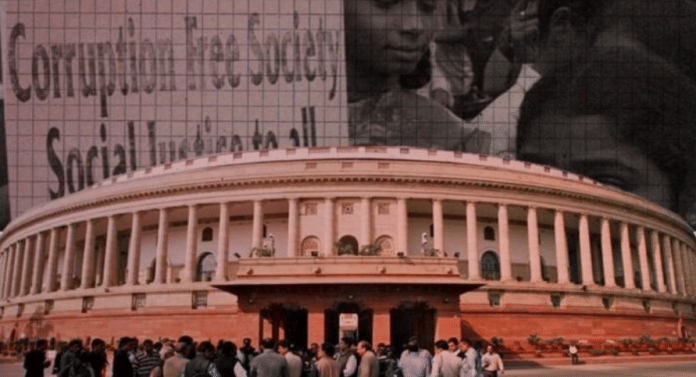Thank you dear subscribers, we are overwhelmed with your response.
Your Turn is a unique section from ThePrint featuring points of view from its subscribers. If you are a subscriber, have a point of view, please send it to us. If not, do subscribe here: https://theprint.in/subscribe/
One common misconception is that corruption can be eradicated overnight through street protests or violence—an idea that is unrealistic and has never been successful in the past. Governments that promise to eliminate corruption often end up being even more corrupt than their predecessors, as seen in historical cases such as the Assam Gana Parishad and Arvind Kejriwal’s administration. This is because corruption is deeply embedded in the system and cannot simply be eradicated by changing leaders. Effectively addressing corruption requires a comprehensive approach—one that involves legal reforms, technological advancements and Artificial Intelligence, improvements in judicial processes, and, most importantly, active participation from the public.
Technology, when implemented effectively, serves as a powerful tool for enhancing transparency. Notable examples include railway reservation systems and online income tax filing, both of which have significantly reduced opportunities for corruption and improved accountability. However, some of the most corruption-prone sectors—such as Regional Transport Offices (RTO) and Sub-registrar offices—still require targeted intervention. If a forward-thinking government were to automate processes like the driver’s written test and the issuance of learner’s licenses and outsource these steps while reserving RTO approval for final verification, corruption could be substantially curtailed. Similarly, establishing a national registry of property titles would help minimize corrupt practices in registrar offices. Overall, the widespread adoption of digitization, artificial intelligence, outsourcing, and automation can systematically reduce corruption across various sectors.
The second strategy involves revising standard operating procedures, rules and regulations. Currently, our laws grant extensive discretionary powers to bureaucrats, which often leads to inconsistent enforcement and opportunities for corruption. By rewriting these laws to be clearer and more transparent—and ensuring that non-bureaucrats actively participate in the process—we can significantly reduce corruption. For example, the implementation of direct fines for traffic violations based on Camera has helped limit corrupt practices in that sector. Expanding similar direct enforcement methods to other areas could further mitigate corruption.
Another key reason corruption persists is that many individuals expect to receive services without paying for them, often seeking preferential treatment or expedited results at no cost. If people are willing to pay reasonable fees for faster service—and actively request more efficient government processes—a two-tiered system for service delivery could be both fair and effective. Those who need immediate assistance could opt for premium, expedited service, while others could utilize standard channels. Such an approach would not only accommodate varying needs but also generate additional support jobs, thereby alleviating the burden on government employees and helping to streamline operations. By embracing transparent, tiered service models, we can reduce the incentives for corruption and improve overall efficiency.
The fourth strategy is for citizens to actively vote in favor of candidates who support corruption-free governance. When the electorate demonstrates a strong preference for integrity and transparency, politicians are more likely to prioritize these values in their platforms and actions. The blanket notion that all politicians are corrupt is misleading; there are individuals committed to honest leadership, but they often fail to get re-elected due to voter apathy or cynicism. By making corruption-free governance a key criterion at the ballot box, voters can help shift the political landscape toward greater accountability and reduce the prevalence of corrupt practices.
Finally, judicial reforms must focus on ensuring swift and time-bound case resolution. Courts should process cases more efficiently by imposing strict limits on the number of hearings and restricting postponements or adjournments. Currently, those engaged in corrupt practices exploit lengthy legal proceedings, dragging out cases indefinitely and causing hardship for the disadvantaged party. By enacting laws that require all cases to be resolved within a maximum of one year, the overall caseload would decrease, and frivolous lawsuits would be discouraged. Ultimately, it is essential for each of us to commit to gradually improving our own behaviors—making small, consistent changes one day and one action at a time.
Where does meaningful reform begin? It starts at the highest levels—in Delhi’s Parliament and the state capitals—by simplifying laws, closing loopholes, and clearly defining procedures. Rule changes should be proposed by those directly impacted, with input from civil society to help shape a modern, transparent thought process. For example, India currently lacks comprehensive laws protecting international travelers and specifying penalties for delays and cancellations. We could adopt proven frameworks from the EU, Canada, and Britain, implementing their regulations almost verbatim.
Establishing a web portal where citizens can suggest legal changes and track legislative action would increase public engagement. While there may be skepticism, if even 10% of each constituency consistently demands reform, politicians will be compelled to respond—after all, many elections are won or lost by margins smaller than this. End of the day eliminating the agents, brokers and others and instead a proper service queue is what will reduce corruption and not street violence and it starts in legislature and votes.
These pieces are being published as they have been received – they have not been edited/fact-checked by ThePrint.


